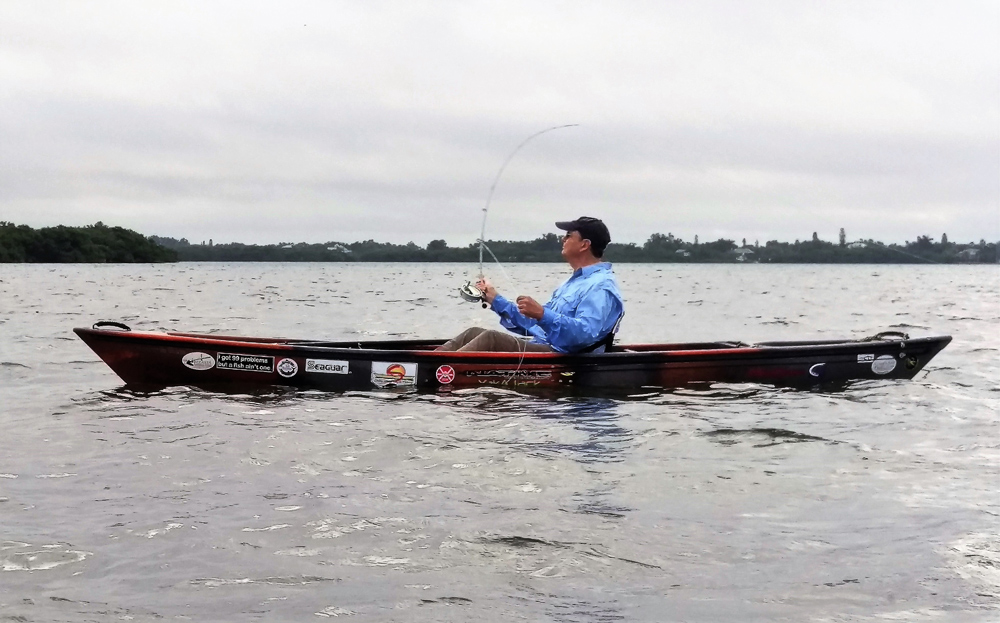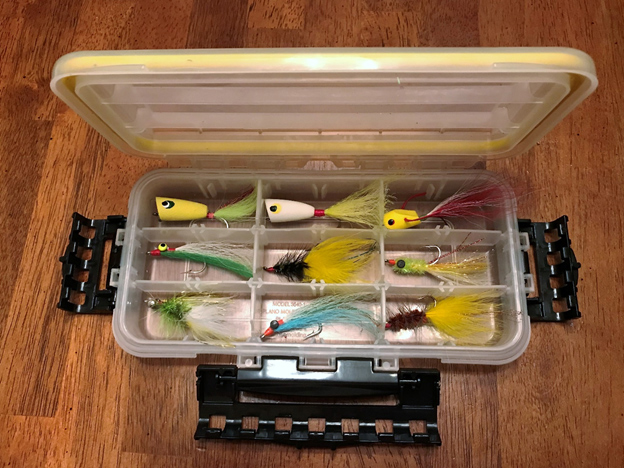Chesapeake Bay fishing offers many opportunities to try fly fishing from a kayak while protected from gusting wind and large boat wakes. From Anne Arundel County’s 500 miles of tidal shoreline to DelMarVa’s Eastern Shore to Tidewater Virginia there are many places to launch a kayak. Once on those waterways, you can explore the many creeks that feed into them to catch white perch, stripers, and pickerel on the fly; a short trip to freshwater areas mean crappie, bass, and pickerel await your poppers and streamers.

Kayak fishing has exploded in popularity in recent years, and fishing kayaks and the equipment on them has become increasingly specialized and complex. What I like most about kayak fly fishing, however, is its simplicity. A single fly rod, or maybe two, and a small box of flies will provide hours of enjoyment on our local small waters. As for the kayak itself, the good news is that there is no “best” kayak for fly fishing. Almost any kayak will work. But there are a few important considerations: comfort, transportability and trackability.
I want a comfortable boat because my sessions on the water may last three or four hours and a supportive seat is critical. Transportability is an issue because I car-top my kayak, and if you plan to do the same, you need to be able to lift it, remove it from the roof of the vehicle, and get it to the water. Trackability is how well it handles on the water. Is it easy to paddle and does it glide straight? Generally speaking, the longer a kayak, the easier it is to paddle and the straighter it tracks. But, the longer the kayak is the more it weighs. My preferred boat is a compromise at 12 feet in length, a 49-pound Native Ultimate 12.
“Ah, but don’t you have to stand to cast a fly rod?” That’s the question I most often hear from folks when I tell them I fly fish from a kayak. The answer is absolutely not. Kayak fly casting is a close-contact sport where short casts reign. Rarely do you need to throw more than 40 to 50 feet of line, since the kayak itself allows you to stealthily approach your target. Even though my particular kayak is stable enough to stand there’s simply no need to.
To cast while seated, however, a balanced fly outfit is a must. For most kayak fly fishing a six-weight, nine-foot rod with floating weight-forward line is a good choice. Occasionally you may want to carry a second rod, maybe an eight-weight with intermediate line, especially in the fall when stripers are thick in tidal creeks.
Leaders and tippets can be kept simple, since most of these species are not leader shy. A regular tapered bass leader with a 10-pound tippet will suffice, or even a straight piece of 10- or 12-pound mono will work in a pinch. I prefer eight to nine-foot leaders, especially when fishing streamers, so they can sink a bit.

Line control is an issue that kayak fly anglers must contend with. With floating line, you can simply drop the stripped line overboard with your left hand. It floats along the side of the kayak in the same way it would float near your legs if you were wade-fishing. If space allows in your kayak you can drop it to the floor of your boat, just make sure nothing else is on the floor to entangle it. One of the truths of kayak fly fishing is that if your line can find something to snag on in your boat, it will. For that reason, I keep the left gunnel of my kayak completely clear. I cast right-handed and my casts most often are directed to the left of my bow. All attachments, such as the paddle holder, are therefore positioned on the right side of the boat.
Now, I must admit that personally, I also use conventional tackle while kayak fishing and in addition to my paddle kayak I have a pedal-driven model that allows me to troll jigs and crankbaits while covering miles of water in a single outing. But by far, my most enjoyable times kayak fishing are when I’m slowly working shorelines in tidal creeks and freshwater ponds with a fly rod. It’s analogous to wading a quiet trout stream – incredibly peaceful, relaxing, and very rewarding. And if you try the union of kayaking and angling, I think you’ll be just as hooked as the fish you’ll catch.
- By Mark Bange, the author of “The Simple Joys of Kayak Fishing,” and is president of the Free State Fly Fishers (FSFF). For more information about the FSFF please visit its website, or its Facebook page.